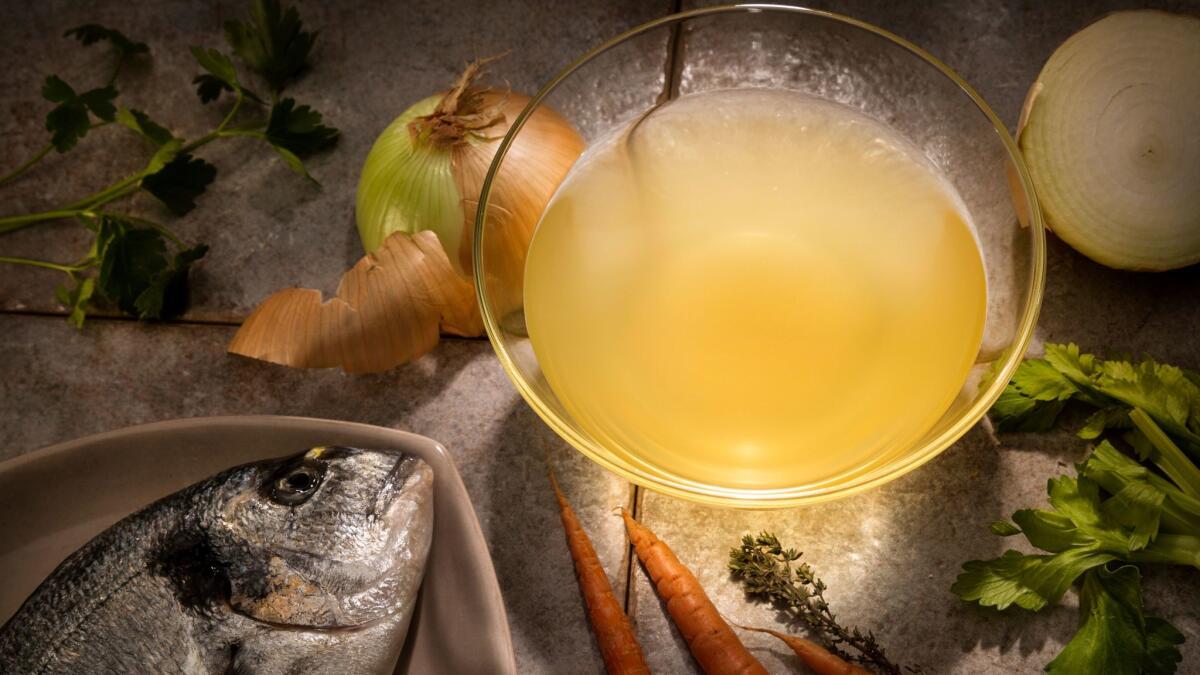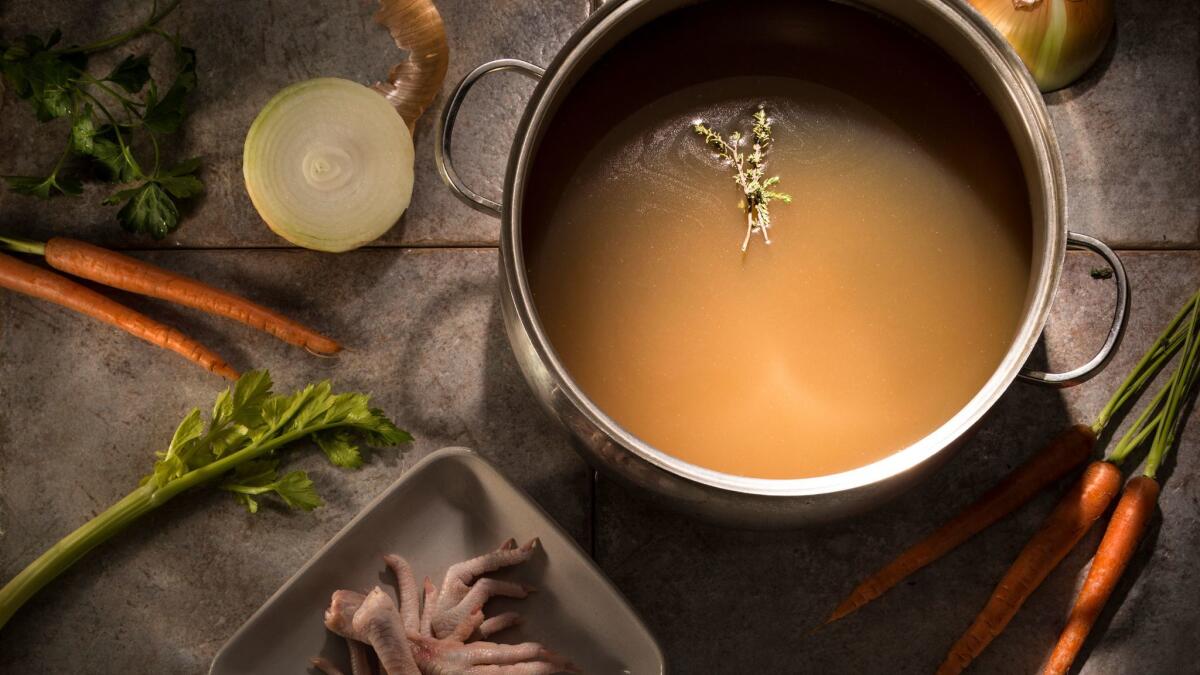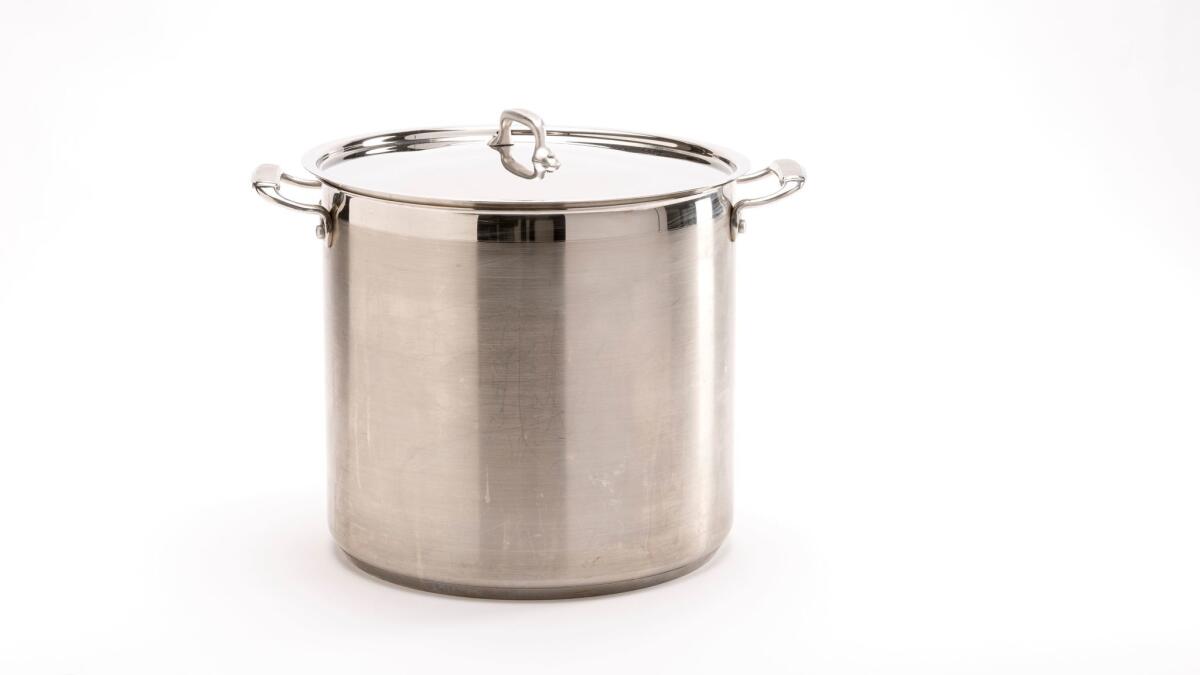Why all the fuss over bone broth? It’s just a fancy name for stock

Ever heard of bone broth? At least as a term, bone broth is relatively new, popularized — even hipsterized — by the rise of the Paleo diet, which focuses on the consumption of meat, fish, vegetables and fruit, or the kinds of foods that may have formed our diet during the Paleolithic era. The broth, usually homemade but increasingly available at shops and through special order, boasts a thick texture with a pronounced flavor, and it’s the latest darling of the health food world, with cookbooks, websites and even a local restaurant devoted to the stuff.
“One of the reasons I wanted to open a bone broth concept is it’s so unique. I haven’t seen this much in L.A.” says Erwin Tjahyadi, chef at the new restaurant Bone Kettle in Pasadena. “Bone broth is comfort food. And it’s got a lot of vitamins and collagen.”
Proponents of bone broth, which is touted as a new superfood by some, the next miracle elixir by others, rattle off a laundry list of benefits, arguing that it combats everything from rough skin and joint pain to arthritis, intestinal issues and even hormonal imbalances. Brothing might just be the new juicing.
Recipe: Basic brown beef or veal stock »
So what is bone broth? Essentially, the liquid is nothing more than a pot of bones and water, maybe vegetables and herbs as well, slowly simmered for hours until all of the flavors and nutrients are extracted from the ingredients. Which, of course, sounds an awful lot like stock, that lowly kitchen staple.
“I think it’s kind of funny,” says Michael Ruhlman, award-winning food writer, cookbook author (among others, he co-wrote Thomas Keller’s “The French Laundry Cookbook”) and cooking authority. “ ‘Bone broth’ is a marketing device. There’s no difference between bone broth and stock, and I’d like to talk to anyone who says otherwise, period.”
The label may be new, but bone broth is about as revolutionary a technique as live-fire cooking. And, of course, pots of bone-based stock are one of the fundamental building blocks of classic French and other cuisines as well as a basic kitchen utility, born out of a desire to use every trimming and kitchen scrap, from leftover bones to wilted parsley stems.

Unsurprisingly for an age-old recipe built on little more than bones and water, a great pot of whatever you want to call this stuff is easy to make at home. Just be sure to give yourself plenty of time.
The most important ingredient of a good bone broth is — wait for it — the bones. Bones define the type of stock (beef, veal, chicken, fish) and determine its flavor and thickness, and you’ll want five to six pounds for about every gallon of stock you make.
You can use almost any bones, but certain types are prized. Those high in cartilage, such as knuckle bones, make terrific stock, as the collagen in the cartilage thickens the liquid, providing body as well as flavor. Neck and back bones, as well as feet, are also very good for this. As collagen is heated, it transforms into gelatin (think Jell-O); release enough gelatin into a stock and it will solidify when chilled. If possible, cut up the bones so the pieces are no bigger than a few inches each; this will allow their components to break down more quickly and easily.
Bones lend texture and definition to the stock, but it’s meat that contributes real flavor, particularly tougher meats that are high in connective tissue, another source of collagen.
“Meat has all the flavor. I don’t like the flavor of bones,” says Ruhlman. “What you want is a high-meat, high-cartilage, low-bone ratio for the best broth. I like the flavor of meat and sweet, aromatic vegetables.”
Look for meaty knuckle bones or leftover chicken carcasses (raw is best, but the picked-over bones from a roast chicken work well too), as well as trimmings from a roast or a braise.
For richer flavor, roast the bones first: Place the bones on a tray in a 450-degree oven until they’re dark and brown, a half hour or so before adding them to a stock.
In addition to bones, consider other flavorings, such as vegetables or herbs. For a classic French stock, a blend of onions, carrots and celery — called mirepoix — is added, along with things like parsley, thyme and whole peppercorns or cloves.

Tjahyadi, who is from Indonesia, fuses Korean and Vietnamese methods with French technique. “Koreans use femur bones, and I love to use Vietnamese herbs and ingredients.”
Once you have your stock cooking, keep it at a gentle simmer, skimming off any foam, fat or other impurities that rise to the surface. Depending on the stock, cooking times can range from as little as 45 minutes (for fish) to several hours or more (beef, veal and game). Many bone broth advocates call for even longer cooking times, such as a day or more. Tjahyadi cooks his broth for 36 hours.
Keep in mind that as the ingredients slowly infuse the stock, the prolonged cooking will also result in evaporation, concentrating the flavor of the stock and thickening its texture. This is called reduction. Because of this, avoid seasoning the stock until you have finished cooking it; otherwise, the seasoning may be too much for the stock.
After you’ve made a batch of stock, use it as a base for soups and stews, gravies and sauces. Or just enjoy it by the glass.
“I don’t like the term bone broth, but I love the trend,” says Ruhlman. “I love that people are enjoying something so healthy and nutritious.”
I think we can all drink to that.
Kitchen gadget: Stock pot

Simple as it may seem, the stock pot is one of the most essential tools of the kitchen. Whether you’re cooking a pot of soup or stew, steaming lobsters, canning or just simmering a batch of, well, stock, you want a pot that’s up to the task.
Unlike smaller pots and saucepans, a stock pot should have a wide base, giving you ample room to sauté larger quantities of vegetables or meat. And the pan itself should be thick, able to conduct heat well and fitted with sturdy handles so you can move it easily. A good stock pot should also come with a tight-fitting lid. Finally, look for a pot that will hold at least 8 to 12 quarts, large enough to handle the big jobs in the kitchen, so you don’t have to split your work between two or three smaller containers.
Stock pots vary in price depending on their size and material. Although aluminum is often cheaper than other materials and conducts heat well, look for a pot that is made of, or at least layered with stainless steel or another nonreactive material that will prevent acidic foods and ingredients (read: tomatoes) from picking up metallic flavors from the pot.
Stock pots can be found at specialty cooking and department stores, as well as online. Prices range from $15 to $400 and more.
ALSO:
Recipes ready in 30 minutes or less
Get outdoors: Easy weeknight grilling recipes
Browse our Recipe Database for thousands of our best recipes
More to Read
Eat your way across L.A.
Get our weekly Tasting Notes newsletter for reviews, news and more.
You may occasionally receive promotional content from the Los Angeles Times.







